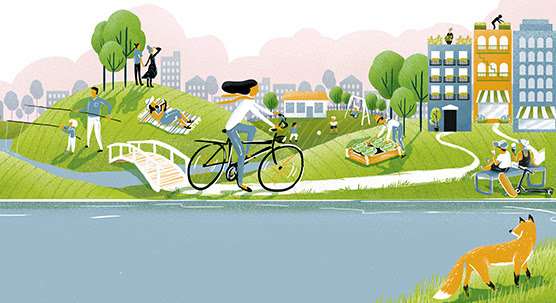Access to nature
Reorganising natural areas needed for health
Published : 25 Aug 2017, 02:06
Updated : 25 Aug 2017, 10:42
The health and wellbeing impacts of contacts with nature are getting increasing focus in discussions on environmental policies in Finland and across Europe, found a study conducted by the Green Infrastructure Unit of Finnish Environment Institute (SYKE).
Access to nature is important, even in densely populated residential districts. Such benefits can best be realised through coherent planning, said a SYKE press release.
“Planners need to enter into purposeful dialogues, involving as wide a range of stakeholders as possible – including the people who actually use urban nature and public transport developers as well as planners and architects,” said Riikka Paloniemi, the head of SYKE’s Green Infrastructure Unit.
To promote effective participatory planning, it is important that the health benefits of local natural areas should be more widely recognised, and considered in planning procedures from the regional level right down to the very local level.
Responsibility for planning green areas in urban settings should also be allocated more clearly, said the study report.
The varying characteristics of different types of urban districts must always be duly considered in planning, it said, since needs and opportunities in relation to urban nature are quite different in central districts and more in suburban locations. Access to nature is particularly important for children.
Paloniemi said, “Areas of forest, parks and other elements of urban nature should especially be accessible near kindergartens and primary schools. Ideally, their use can then be deeply integrated into routines and educational syllabuses.”
Opportunities for more than 1,000 kindergartens in the Helsinki Metropolitan Area to enjoy recreational activities in local green areas have been assessed by SYKE, using GIS data.
The planning guidelines issued by the environment ministry recommend that natural areas suitable for recreational activities should be accessible within 300 metres of all residential areas.
The study findings showed that more than half of the kindergartens were located more than 300 metres away from the nearest area of forest, but more formal parks play a valuable complementary role to forest areas in the overall network of urban recreational areas. Only about 20 kindergartens were located more than 300 metres away from the nearest park or area of forest.
In natural settings, children are beneficially exposed to microbes, strengthening their immune systems. Reduced exposure to natural microbes impoverishes the microbiota in their bodies, thereby reducing their resistance. This in turn leads to problems such as inflammatory conditions and atopic sensitisation, reflected in the prevalence of conditions such as allergies and asthma. The research findings support a theory known as “the biodiversity hypothesis” by showing, for example, that the distances between the homes of children and the nearest areas of forest or farmland are reflected in the levels of atopic sensitisation.


